2005 BMW 325I SPORT WAGON oil pressure
[x] Cancel search: oil pressurePage 10 of 178
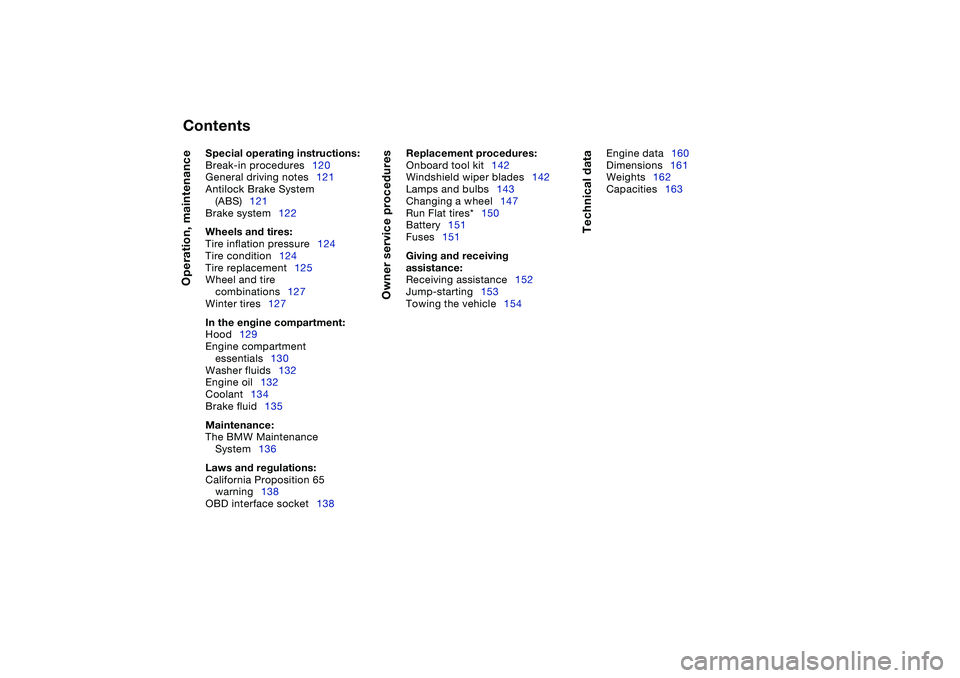
Contents
Operation, maintenance
Special operating instructions:
Break-in procedures120
General driving notes121
Antilock Brake System
(ABS)121
Brake system122
Wheels and tires:
Tire inflation pressure124
Tire condition124
Tire replacement125
Wheel and tire
combinations127
Winter tires127
In the engine compartment:
Hood129
Engine compartment
essentials130
Washer fluids132
Engine oil132
Coolant134
Brake fluid135
Maintenance:
The BMW Maintenance
System136
Laws and regulations:
California Proposition 65
warning138
OBD interface socket138
Owner service procedures
Replacement procedures:
Onboard tool kit142
Windshield wiper blades142
Lamps and bulbs143
Changing a wheel147
Run Flat tires*150
Battery151
Fuses151
Giving and receiving
assistance: Receiving assistance152
Jump-starting153
Towing the vehicle154
Technical data
Engine data160
Dimensions161
Weights162
Capacities163
Page 18 of 178
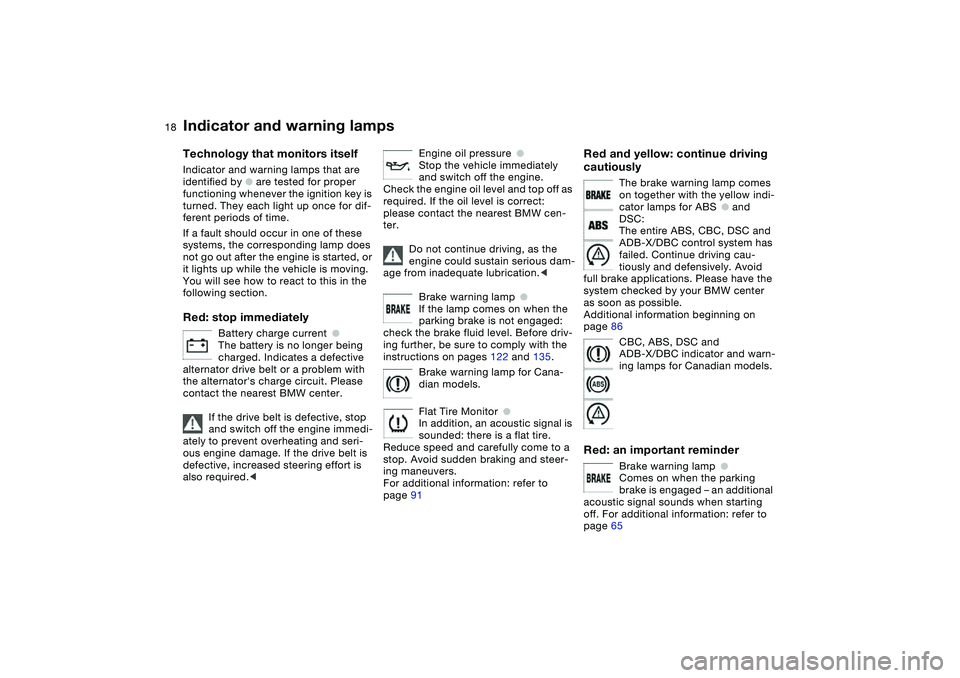
18
Indicator and warning lamps
Technology that monitors itself
Indicator and warning lamps that are
identified by
●
are tested for proper
functioning whenever the ignition key is
turned. They each light up once for dif-
ferent periods of time.
If a fault should occur in one of these
systems, the corresponding lamp does
not go out after the engine is started, or
it lights up while the vehicle is moving.
You will see how to react to this in the
following section.
Red: stop immediately
Battery charge current
●
The battery is no longer being
charged. Indicates a defective
alternator drive belt or a problem with
the alternator's charge circuit. Please
contact the nearest BMW center.
If the drive belt is defective, stop
and switch off the engine immedi-
ately to prevent overheating and seri-
ous engine damage. If the drive belt is
defective, increased steering effort is
also required.
<
Engine oil pressure
●
Stop the vehicle immediately
and switch off the engine.
Check the engine oil level and top off as
required. If the oil level is correct:
please contact the nearest BMW cen-
ter.
Do not continue driving, as the
engine could sustain serious dam-
age from inadequate lubrication.
<
Brake warning lamp
●
If the lamp comes on when the
parking brake is not engaged:
check the brake fluid level. Before driv-
ing further, be sure to comply with the
instructions on pages 122 and 135.
Brake warning lamp for Cana-
dian models.
Flat Tire Monitor
●
In addition, an acoustic signal is
sounded: there is a flat tire.
Reduce speed and carefully come to a
stop. Avoid sudden braking and steer-
ing maneuvers.
For additional information: refer to
page 91
Red and yellow: continue driving
cautiously
The brake warning lamp comes
on together with the yellow indi-
cator lamps for ABS
●
and
DSC:
The entire ABS, CBC, DSC and
ADB-X/DBC control system has
failed. Continue driving cau-
tiously and defensively. Avoid
full brake applications. Please have the
system checked by your BMW center
as soon as possible.
Additional information beginning on
page 86
CBC, ABS, DSC and
ADB-X/DBC indicator and warn-
ing lamps for Canadian models.
Red: an important reminder
Brake warning lamp
●
Comes on when the parking
brake is engaged – an additional
acoustic signal sounds when starting
off. For additional information: refer to
page 65
Page 127 of 178
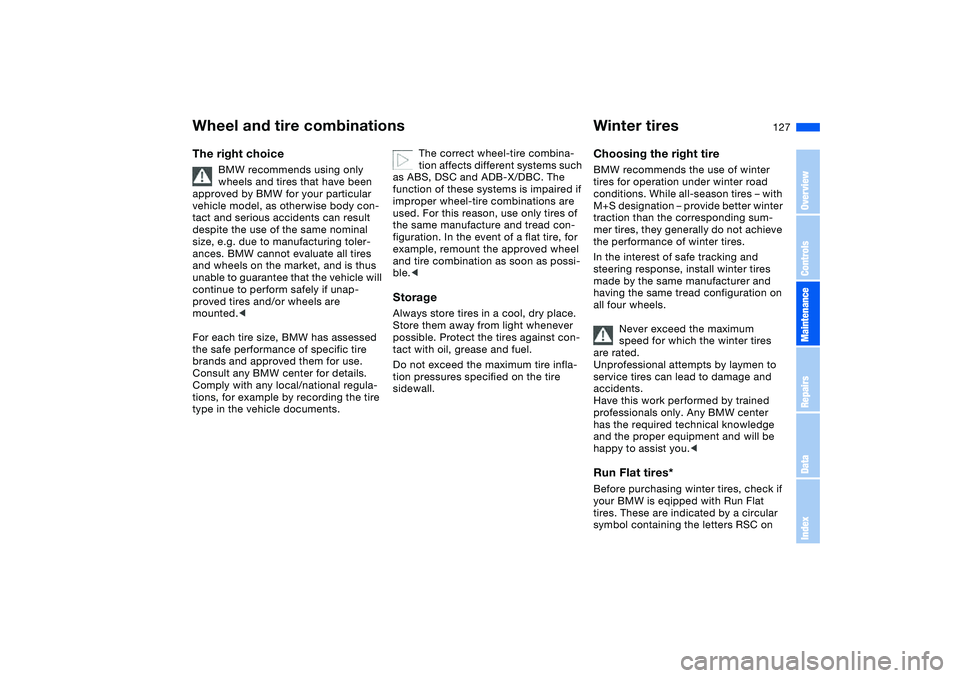
127
Wheel and tire combinationsThe right choice
BMW recommends using only
wheels and tires that have been
approved by BMW for your particular
vehicle model, as otherwise body con-
tact and serious accidents can result
despite the use of the same nominal
size, e.g. due to manufacturing toler-
ances. BMW cannot evaluate all tires
and wheels on the market, and is thus
unable to guarantee that the vehicle will
continue to perform safely if unap-
proved tires and/or wheels are
mounted.<
For each tire size, BMW has assessed
the safe performance of specific tire
brands and approved them for use.
Consult any BMW center for details.
Comply with any local/national regula-
tions, for example by recording the tire
type in the vehicle documents.
The correct wheel-tire combina-
tion affects different systems such
as ABS, DSC and ADB-X/DBC. The
function of these systems is impaired if
improper wheel-tire combinations are
used. For this reason, use only tires of
the same manufacture and tread con-
figuration. In the event of a flat tire, for
example, remount the approved wheel
and tire combination as soon as possi-
ble.<
StorageAlways store tires in a cool, dry place.
Store them away from light whenever
possible. Protect the tires against con-
tact with oil, grease and fuel.
Do not exceed the maximum tire infla-
tion pressures specified on the tire
sidewall.
Winter tiresChoosing the right tireBMW recommends the use of winter
tires for operation under winter road
conditions. While all-season tires – with
M+S designation – provide better winter
traction than the corresponding sum-
mer tires, they generally do not achieve
the performance of winter tires.
In the interest of safe tracking and
steering response, install winter tires
made by the same manufacturer and
having the same tread configuration on
all four wheels.
Never exceed the maximum
speed for which the winter tires
are rated.
Unprofessional attempts by laymen to
service tires can lead to damage and
accidents.
Have this work performed by trained
professionals only. Any BMW center
has the required technical knowledge
and the proper equipment and will be
happy to assist you.
tires. These are indicated by a circular
symbol containing the letters RSC on
OverviewControlsMaintenanceRepairsDataIndex
Page 134 of 178
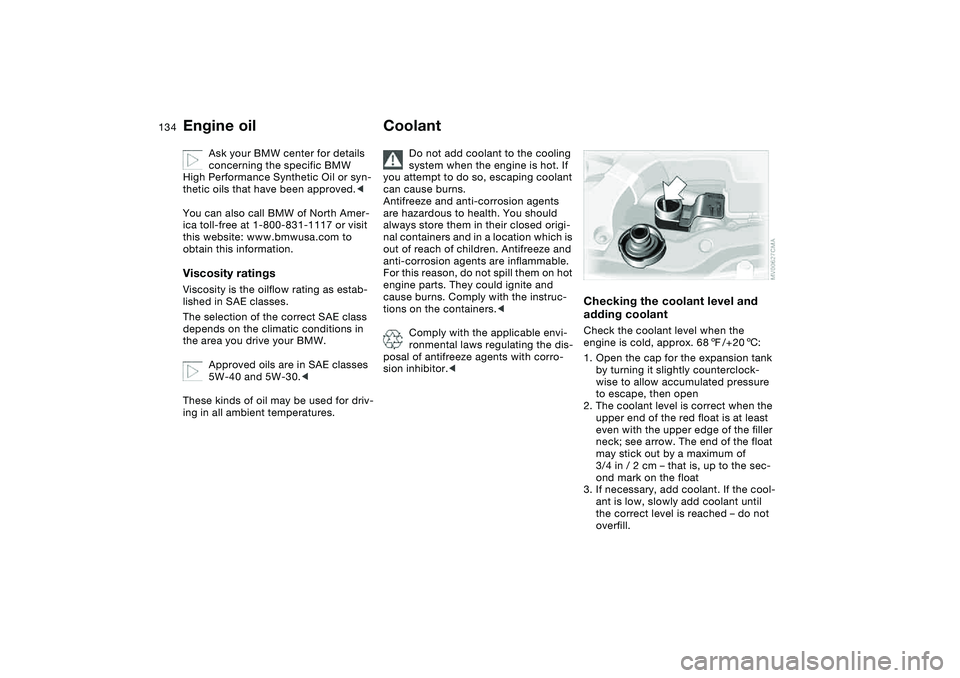
134
Ask your BMW center for details
concerning the specific BMW
High Performance Synthetic Oil or syn-
thetic oils that have been approved.<
You can also call BMW of North Amer-
ica toll-free at 1-800-831-1117 or visit
this website: www.bmwusa.com to
obtain this information.
Viscosity ratingsViscosity is the oilflow rating as estab-
lished in SAE classes.
The selection of the correct SAE class
depends on the climatic conditions in
the area you drive your BMW.
Approved oils are in SAE classes
5W-40 and 5W-30.<
These kinds of oil may be used for driv-
ing in all ambient temperatures.
Coolant
Do not add coolant to the cooling
system when the engine is hot. If
you attempt to do so, escaping coolant
can cause burns.
Antifreeze and anti-corrosion agents
are hazardous to health. You should
always store them in their closed origi-
nal containers and in a location which is
out of reach of children. Antifreeze and
anti-corrosion agents are inflammable.
For this reason, do not spill them on hot
engine parts. They could ignite and
cause burns. Comply with the instruc-
tions on the containers.<
Comply with the applicable envi-
ronmental laws regulating the dis-
posal of antifreeze agents with corro-
sion inhibitor.<
Checking the coolant level and
adding coolantCheck the coolant level when the
engine is cold, approx. 687/+206:
1. Open the cap for the expansion tank
by turning it slightly counterclock-
wise to allow accumulated pressure
to escape, then open
2. The coolant level is correct when the
upper end of the red float is at least
even with the upper edge of the filler
neck; see arrow. The end of the float
may stick out by a maximum of
3/4 in / 2 cm – that is, up to the sec-
ond mark on the float
3. If necessary, add coolant. If the cool-
ant is low, slowly add coolant until
the correct level is reached – do not
overfill.
Engine oil
Page 169 of 178
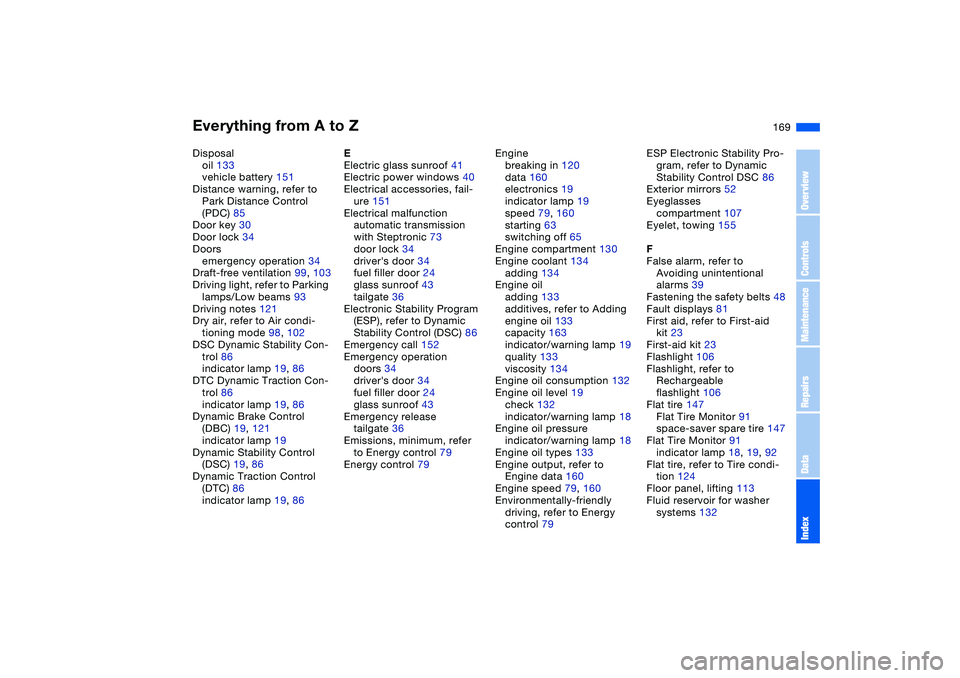
Everything from A to Z
169
Disposal
oil 133
vehicle battery 151
Distance warning, refer to
Park Distance Control
(PDC) 85
Door key 30
Door lock 34
Doors
emergency operation 34
Draft-free ventilation 99, 103
Driving light, refer to Parking
lamps/Low beams 93
Driving notes 121
Dry air, refer to Air condi-
tioning mode 98, 102
DSC Dynamic Stability Con-
trol 86
indicator lamp 19, 86
DTC Dynamic Traction Con-
trol 86
indicator lamp 19, 86
Dynamic Brake Control
(DBC) 19, 121
indicator lamp 19
Dynamic Stability Control
(DSC) 19, 86
Dynamic Traction Control
(DTC) 86
indicator lamp 19, 86E
Electric glass sunroof 41
Electric power windows 40
Electrical accessories, fail-
ure 151
Electrical malfunction
automatic transmission
with Steptronic 73
door lock 34
driver's door 34
fuel filler door 24
glass sunroof 43
tailgate 36
Electronic Stability Program
(ESP), refer to Dynamic
Stability Control (DSC) 86
Emergency call 152
Emergency operation
doors 34
driver's door 34
fuel filler door 24
glass sunroof 43
Emergency release
tailgate 36
Emissions, minimum, refer
to Energy control 79
Energy control 79Engine
breaking in 120
data 160
electronics 19
indicator lamp 19
speed 79, 160
starting 63
switching off 65
Engine compartment 130
Engine coolant 134
adding 134
Engine oil
adding 133
additives, refer to Adding
engine oil 133
capacity 163
indicator/warning lamp 19
quality 133
viscosity 134
Engine oil consumption 132
Engine oil level 19
check 132
indicator/warning lamp 18
Engine oil pressure
indicator/warning lamp 18
Engine oil types 133
Engine output, refer to
Engine data 160
Engine speed 79, 160
Environmentally-friendly
driving, refer to Energy
control 79ESP Electronic Stability Pro-
gram, refer to Dynamic
Stability Control DSC 86
Exterior mirrors 52
Eyeglasses
compartment 107
Eyelet, towing 155
F
False alarm, refer to
Avoiding unintentional
alarms 39
Fastening the safety belts 48
Fault displays 81
First aid, refer to First-aid
kit 23
First-aid kit 23
Flashlight 106
Flashlight, refer to
Rechargeable
flashlight 106
Flat tire 147
Flat Tire Monitor 91
space-saver spare tire 147
Flat Tire Monitor 91
indicator lamp 18, 19, 92
Flat tire, refer to Tire condi-
tion 124
Floor panel, lifting 113
Fluid reservoir for washer
systems 132
OverviewControlsMaintenanceRepairsDataIndex
Page 172 of 178
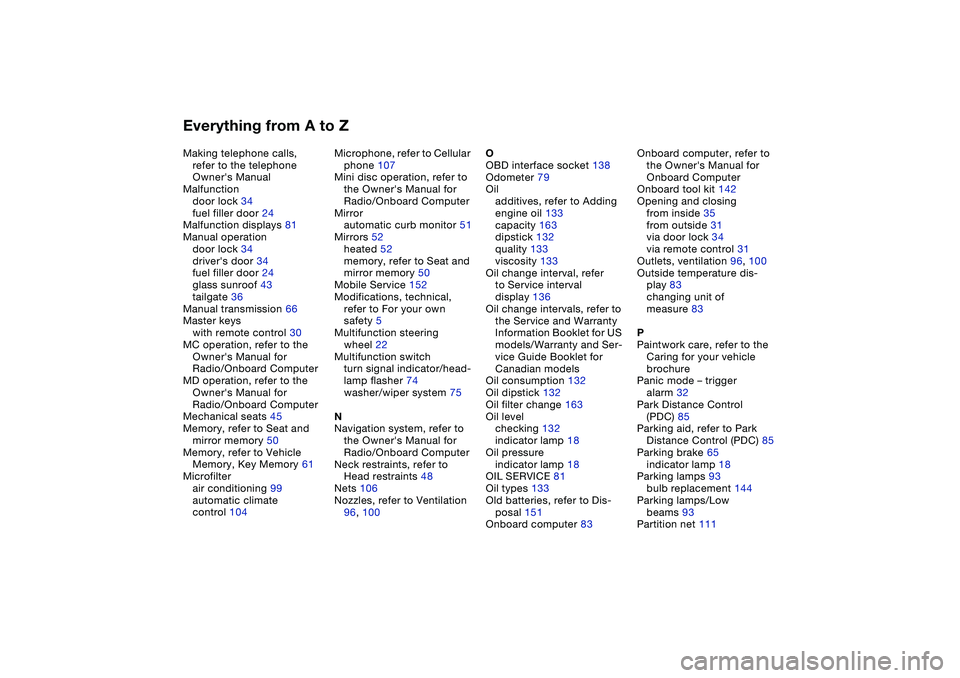
Everything from A to ZMaking telephone calls,
refer to the telephone
Owner's Manual
Malfunction
door lock 34
fuel filler door 24
Malfunction displays 81
Manual operation
door lock 34
driver's door 34
fuel filler door 24
glass sunroof 43
tailgate 36
Manual transmission 66
Master keys
with remote control 30
MC operation, refer to the
Owner's Manual for
Radio/Onboard Computer
MD operation, refer to the
Owner's Manual for
Radio/Onboard Computer
Mechanical seats 45
Memory, refer to Seat and
mirror memory 50
Memory, refer to Vehicle
Memory, Key Memory 61
Microfilter
air conditioning 99
automatic climate
control 104Microphone, refer to Cellular
phone 107
Mini disc operation, refer to
the Owner's Manual for
Radio/Onboard Computer
Mirror
automatic curb monitor 51
Mirrors 52
heated 52
memory, refer to Seat and
mirror memory 50
Mobile Service 152
Modifications, technical,
refer to For your own
safety 5
Multifunction steering
wheel 22
Multifunction switch
turn signal indicator/head-
lamp flasher 74
washer/wiper system 75
N
Navigation system, refer to
the Owner's Manual for
Radio/Onboard Computer
Neck restraints, refer to
Head restraints 48
Nets 106
Nozzles, refer to Ventilation
96, 100O
OBD interface socket 138
Odometer 79
Oil
additives, refer to Adding
engine oil 133
capacity 163
dipstick 132
quality 133
viscosity 133
Oil change interval, refer
to Service interval
display 136
Oil change intervals, refer to
the Service and Warranty
Information Booklet for US
models/Warranty and Ser-
vice Guide Booklet for
Canadian models
Oil consumption 132
Oil dipstick 132
Oil filter change 163
Oil level
checking 132
indicator lamp 18
Oil pressure
indicator lamp 18
OIL SERVICE 81
Oil types 133
Old batteries, refer to Dis-
posal 151
Onboard computer 83Onboard computer, refer to
the Owner's Manual for
Onboard Computer
Onboard tool kit 142
Opening and closing
from inside 35
from outside 31
via door lock 34
via remote control 31
Outlets, ventilation 96, 100
Outside temperature dis-
play 83
changing unit of
measure 83
P
Paintwork care, refer to the
Caring for your vehicle
brochure
Panic mode – trigger
alarm 32
Park Distance Control
(PDC) 85
Parking aid, refer to Park
Distance Control (PDC) 85
Parking brake 65
indicator lamp 18
Parking lamps 93
bulb replacement 144
Parking lamps/Low
beams 93
Partition net 111
Page 177 of 178
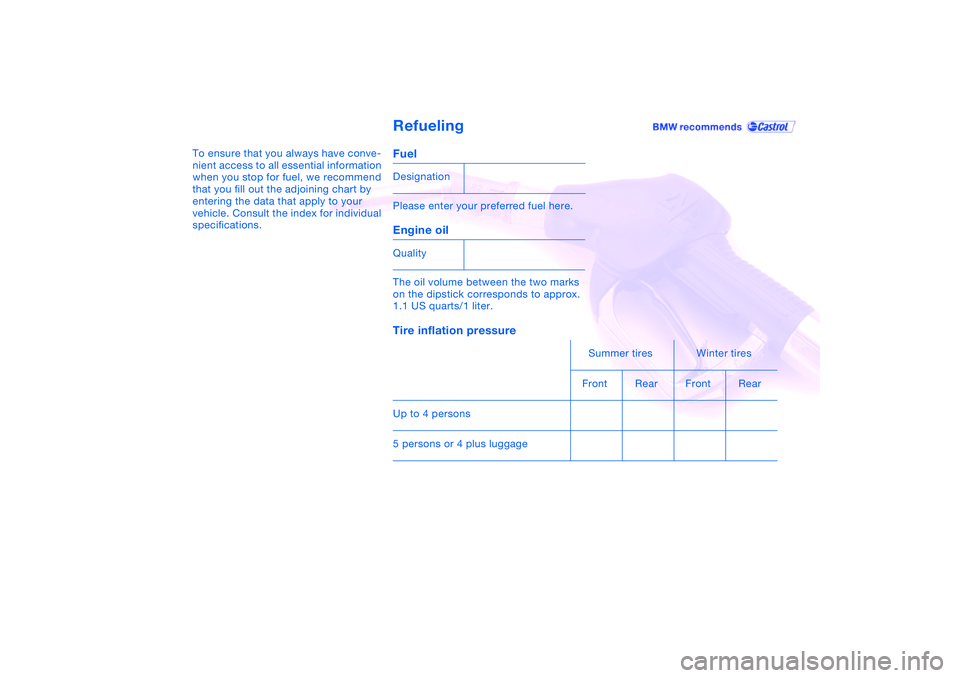
Refueling
To ensure that you always have conve-
nient access to all essential information
when you stop for fuel, we recommend
that you fill out the adjoining chart by
entering the data that apply to your
vehicle. Consult the index for individual
specifications.
FuelPlease enter your preferred fuel here.Engine oilThe oil volume between the two marks
on the dipstick corresponds to approx.
1.1 US quarts/1 liter.Tire inflation pressureDesignation
Quality
Summer tires Winter tires
Front Rear Front Rear
Up to 4 persons
5 persons or 4 plus luggage